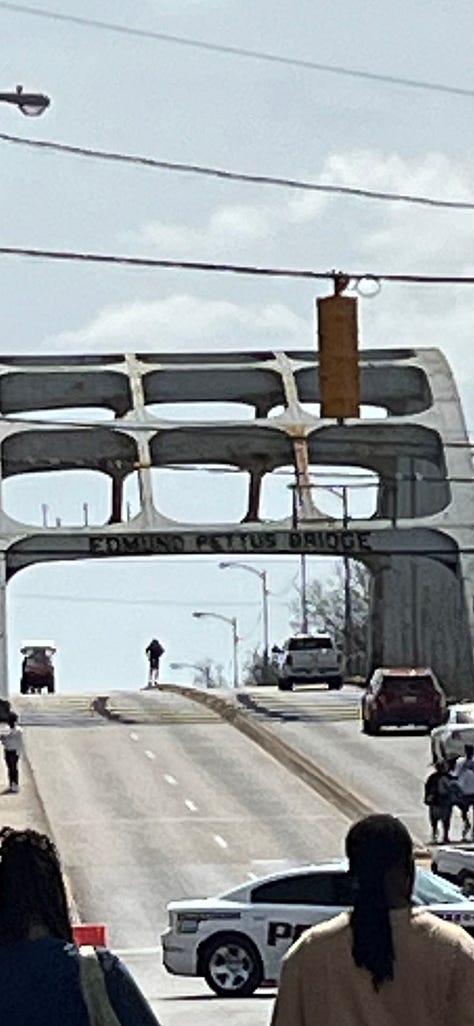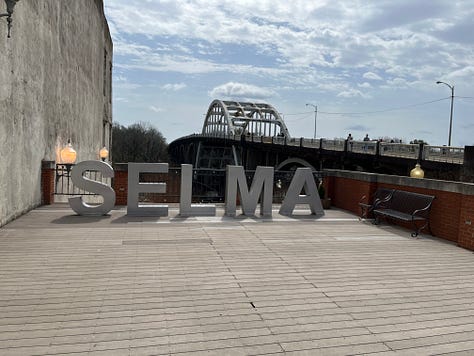Selma at 60
I was in Selma for the 60th anniversary of “Bloody Sunday.” It was an emotional experience. For some reason, I had convinced myself that I have been to Selma before. I have written about James Baldwin’s visit in 1963 and his return for the documentary, “I Heard it through the Grapevine.” His eyes became my eyes, I guess. But I have never stepped foot in the city before Friday, March 7, 2025, sixty years to the day when 600 brave souls marched across the Edmund Pettus Bridge.
It was a surreal experience. The Legal Defense Fund had invited me to participate in their annual Voting Rights event at the jubilee. I was blessed to share time with two members of the organization’s extraordinary team, Gary Spencer and Dr. Keisha Moore. I felt deeply the commitment of the LDF staff and its president, Janai Nelson. The energy of Faya Rose Sanders and the other organizers of the Bridge Crossing jubilee was palpable as this anniversary occurred against the backdrop of what a second Trump presidency has already unleashed and promised. Selma mattered even more today.
Gary and Dr. Keisha took me to the Warrant Clinic almost immediately after I landed in Montgomery. (The airport didn’t have the menacing looking white police officers – those dismal three white men holding back the flood – that Jimmy described in No Name in the Street.) The clinic was held at the Elwood Christian Academy led by its prophetic pastor, Gary Lamar Crum, and organized by Growing Real Alternatives Everywhere (GRAE) in partnership with Black Voters Matter. LDF had joined in the effort, too.
As we walked into the school (a nondescript building with panels missing from the ceiling, insulation exposed, and classrooms with an assorted collection of desks — and a 98% graduation rate!), one of the LDF staff declared, with a Baltimore accent, that they needed to see us a bit earlier. Apparently, hundreds of people from Selma had come to have their warrants removed and fines and fees reduced. The clinic aims to help people resolve warrants for traffic violations and other misdemeanor offenses, minor offenses that could lead to the suspension of driver’s licenses and fundamentally disrupt how people live their lives. Forcing some to retreat into the shadows.
I noticed a young woman holding a baby that couldn’t be more than a few weeks old. As we say back home, “that baby just got here.” The woman smiled. Didn’t say much. Just sat and waited patiently. When her partner finally came up to her, he smiled, too, and gently took the baby from her arms. She walked gingerly. He smiled again. They waved goodbye.
I was talking with Anza Becnel, the founder of GRAE, and Wanda Mosley, the National Field Director of Black Voters Matter about the idea behind the Warrant Clinics. Becnel has an infectious energy. He speaks softly, smiles with every word, and power drives each sentence. He told me an origin story of sorts. He was in New Orleans organizing a protest and someone came up to him and said, “These protests are good and all, but what would really help me, man, is if you could help me get my drivers license.” And there it was. Listening closely, the idea of the Warrant Clinic was born.
In the gym at the back of school, the organizers had set up a daycare with a bounce slide and other stations for the children to play. Wanda and I met on the plane to Montgomery. I now saw her in a potato sack race with too little kids. They smoked her. She limped a bit afterwards. Another woman walked onto the gym floor. Her smile wide and bright. She hugged the kids. Laughed. It was April Albright, one of the co-founders of Black Voters Matter. I said, “Your smile lit up the gym.” She said, “Look at this. This is why I’m smiling.”
Something more than commemoration was happening in Selma.
That evening Gary and Dr. Keisha took me to the Dallas County Courthouse. My heart raced. I immediately looked across the street and saw the Federal Building Baldwin described and imagined federal agents standing there, watching, with a wry smile, the brutality. I turned back and saw the steps where Sheriff Jim Clark stood, and where he punched Reverend C.T. Vivian. I shuddered. A mock trial of Project 2025 was finishing up. Ms. Sanders spoke before the next panel convened. She talked about the jubilee, the challenges that Selma still faced, and announced that, after 30 years, this would be her last jubilee as lead organizer. She spoke of the importance of telling the full story of Selma, and how so much of our history was under assault as Trump and DOGE threatened the sale of Civil Rights museums.
Then she told the story of Vera Booker, the nurse who treated Jimmie Lee Jackson, the young activist from Marion, Alabama, who was shot by an Alabama state trooper during a protest in February of 1965. She cared for him for eight days until he died. Ms. Booker talked about Jackson’s first operation by the Black doctor in Selma, Dr. William Dinkins, at the Catholic Hospital, Good Samaritan, in Selma. Ms. Sanders said that it wasn’t the bullet of the state trooper that killed him. But the white doctor who performed a second operation on Jackson, that Dr. Dinkins insisted he didn’t need, killed him. My heart dropped and my mouth flew open.
The next day was the Jubilee parade. One young woman wore her green tights with green Air Force ones, with locked her. She was loud and familiar. Others had their folding chairs, and they sat alongside the road and laughed full-belly laughs. The Jubilee Marshall waved as she sat on the back of a convertible Corvette. The Homecoming court of Wallace Community College in Selma smiled from their float. Several groups of young cheerleaders did their routines. People threw candy and beads. One dance group did the “pop that fan” line dance. A New Orleans-based band played. One woman danced along. I felt at home. A small town feel where people know most folks and are sweet as they can be.
I walked with the parade, took photos with folks who recognized me from MSNBC, and reveled in the beauty of our people. My heart was full.
But along the parade route, one could see the standing contradiction that is Selma. People have been coming to commemorate “Bloody Sunday” for years, but the community feels stuck. Like the past has it by the throat. Gutted and boarded-up buildings line downtown. Homes rot on their foundation. Concordia College sits there like a ghost town. Good Samaritan Hospital abandoned. Landmarks of the tornadoes that rocked the city in 2023 still stand, barely. All of this amid the reverence and celebration of human courage, in a place where poverty soaks everything.
I walked to the Edmund Pettus Bridge. I wanted to do it alone, without the spectacle of cameras and celebrity. I wanted to take in what I felt and what I saw and what still needs to be done. And I thought of a passage from Imani Perry’s magisterial book, Black in Blues:
Black people speak of being haunted by the past: slavery, conquest, Jim Crow, colonialism. But the artists teach us people of today to haunt the past, to whisper to the ancestors and rearrange the materiality of their lives with our care, to show them they are respected and loved.
We do so not with celebrations or commemorations alone, but with the ongoing effort to be truly free. Selma at 60 reminded me of this and I am truly grateful.









I am hoping, Dr. Glaude, that the rich and storied history of black people in this country, the survival stories, the coping strategies, the push back stories, the discovery stories and the creation stories will inform all of us as these grim new days unfold. I look forward, especially, to hearing from the women, who like all women have mostly struggled out of the spotlight, struggled and raised fine children, entered professions that have made a difference, endured scorn and grown beautiful.
Thank you for your powerful reflection - your words brought me there with you and the photos are haunting. We have so much work to do.